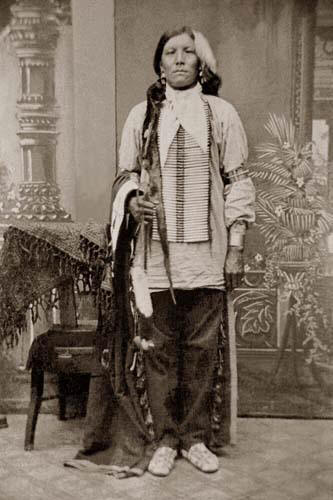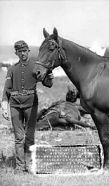|

Where
the Battle of the Little Big Horn began . . .
Garryowen, Montana
Portrait of Chief
Crazy Horse
The Strange Man of the Oglala
"I
thought of things that had happened the last days,
seasons and summers. I began to see that all
things were strung together like beads of a necklace,
one after another, from this day back and this day
forward they went on forever, the hunt, the warpath, the
teaching by Hump and my father and the wounding of
Conquering Bear.
I thought
of other beads: The songs of my mother as we
laughed together when I was a child, the songs I sang to
Little Mouse as I brushed away the mosquitoes and gnats
from her face as she lay in her cradleboard. And
how I told her stories until she fell to sleep. I
saw the face of Little Mouse as she is now, with her
long eyelashes flickering up and down over her smiling,
bright black eyes. It was as if I had returned to
mother earth from another world and she wanted to hold
me to her bosom and whisper in my ear."
-Crazy Horse-
 "There
was never a photograph taken or a likeness made from first hand witness
of Crazy Horse," so said Mari Sandoz in the biography, Crazy Horse,
the Strange Man of the Oglala. "There
was never a photograph taken or a likeness made from first hand witness
of Crazy Horse," so said Mari Sandoz in the biography, Crazy Horse,
the Strange Man of the Oglala.
Her book was
published in 1942. At the time there was little reason to doubt
her words. From eyewitness descriptions, we know that Crazy Horse
was five feet, eight inches tall, lithe and sinewy, with a lean face and
a thin, sharp nose. His countenance was of quiet dignity, but
morose, dogged, tenacious and melancholy. It was said that he
always wore a white buckskin shirt and dark blue leggins, with two
feathers hanging loose in his hair and his long braids wrapped in beaver
fur almost the color of his hair.
He was known
throughout his life as "the light-skinned warrior," In his youth
he was called "Curly" for his light, loose hair, the "color of a young
prairie chick." In The Killing of Chief Crazy Horse (1976,
A.H. Clark Co. of Glendale, California) is a reproduction of an alleged
portrait of Crazy Horse. The book was a collaborative effort of
Robert A. Clark of Spokane, Washington, and Carroll Friswold. The
portrait was first published by J.W. Vaughn in With Crook at the
Rosebud (Stackpole, 1956).
There is a
striking correlation between the eyewitness description of Crazy Horse
and the man in the portrait. The original portrait is a quarter
tintype, 2.5 x 3.5 inches (one of four images on a tintype plate) taken
in the summer of 1877 at Fort Robinson in Crazy Horse's 35th, and last,
year. Its first owner was Baptiste (Little Bat) Garnier.
When Little Bat was murdered in 1900, the tintype went to his wife, a
cousin of Crazy Horse. After her death, it went to her daughter,
Ellen Howard, from whom Fred Hackett acquired it. Hackett and
Vaught published it in 1956. Later, Friswold obtained the tintype
from Hackett with a letter from Ellen Howard attesting to the
authenticity of the tintype.
The image
shown here was taken directly from the tintype, which was scanned at
high resolution and retouched to remove chips and scratches without
changing content by Scott Burgan or Sheridan, Wyoming.
LOOKING
AT THE TINTYPE
Tintypes are
positive prints and are laterally reversed when viewed directly (as one
sees oneself in a mirror). In the linked enlargement the image has been
laterally flipped to present it in the more familiar orientation.
The Face Wound
There are those that claim this tintype is not of Crazy Horse on the
basis that there is no obvious scar on the face of the subject. It is
known that No Water shot Crazy Horse in the face because his wife, Black
Buffalo Robe Woman, rode off with Crazy Horse.
Far too much has been made of this scar on the assumption that it
disfigured the face of Crazy Horse. This is not a valid argument. In a
letter to Will G. Robinson (Secretary of the South Dakota State
Historical Society) on October 19, 1947; Mari Sandoz, in response his
inquiry, stated that the revolver used by No Water to shoot Crazy Horse
was a small caliber that could be hidden in the palm of the hand. He
borrowed it from Bad Heart Bull and, unbeknownst to No Water, the powder
charge was about a half load, to save precious gunpowder. It had been
loaded to hunt rabbits and other small animals. The bullet made a small
wound near the left nostril, traveled along the upper jawbone above the
roots of the teeth and exited out the cheek.
In time this left a slight ridge and, according to eye witnesses,
"...giving that side of Crazy Horse's face a slightly haughty
cast---striking, considering the mildness and gentleness of his face."
Here we need to inspect the picture carefully. Consideration should be
given to the age of the wound. (The picture was taken in 1877, over ten
years after the shooting.) In the picture it can be seen that the left
cheek is more distinct than the right with the skin whitened from an old
scar from below the left nostril to the corner of the mouth. It can best
be described that his face has "a slightly haughty cast," as stated in
Sandoz's letter.
Noteworthy Considerations
A Pose of Peace: Photographs of Indians of the time show them in full
battle dress, wearing a fierce look and holding their favorite weapon, a
rifle, axe or knife. Not so in this picture, the subject is uniquely
without a weapon of any sort and is holding a peace pipe and its tamp
with a clutch of Red Willow branches in his left hand. To the Lakota the
left hand holds spiritual values since it is closest to the heart. (When
greeting a good friend they shake with the left hand.) The Lakota used
the bark of the Red Willow (not tobacco) in the ceremonial smoke of a
peace council.
A Chief's Blanket: He is holding a blanket over his left arm that is
carefully draped for maximum presentation, the border resting on the
floor. At the time of his surrender Crazy Horse's most prized possession
was a red blanket, a chief's blanket. In agreeing to have his picture
taken he would make sure that his blanket would be properly presented in
the photograph. Mari Sandoz stated that Crazy Horse carried his red
blanket folded over his arm as he walked (unwittingly) to the
guardhouse, where he was bayoneted by Private Gentles.
Earrings: are common among the Lakota and each person had their own
style, but most consisted of open rings or long chains, the person in
the picture has short, shell earrings, consistent with those known to be
worn by Crazy Horse as an outgrowth of his vision.
PROVENANCE
 Little
Bat was a good and trusted friend of Crazy Horse. It appears that Little
Bat persuaded Crazy Horse to have his picture taken with the assurance
that it would be kept secret while Crazy Horse still lived. Crazy Horse
wasn't afraid of the "shadow catcher," as stated by many writers. He was
fully aware of how cameras worked; he just didn't want his picture shown
about. He had a lot of enemies, Indian and White, and anonymity was his
best protection. Little
Bat was a good and trusted friend of Crazy Horse. It appears that Little
Bat persuaded Crazy Horse to have his picture taken with the assurance
that it would be kept secret while Crazy Horse still lived. Crazy Horse
wasn't afraid of the "shadow catcher," as stated by many writers. He was
fully aware of how cameras worked; he just didn't want his picture shown
about. He had a lot of enemies, Indian and White, and anonymity was his
best protection.
Through the
dedicated efforts of Peter Abiuso, an amateur historical sleuth, the
original tintype and Howard's letter were found in the effects of
Carroll Friswold's estate. They were sold at auction by Butterfield
Auctions of Los Angeles, California in December 2000 and later acquired
by the Custer Battlefield Museum at Crow Agency,
Montana where they are now available for public viewing. |

 "There
was never a photograph taken or a likeness made from first hand witness
of Crazy Horse," so said Mari Sandoz in the biography, Crazy Horse,
the Strange Man of the Oglala.
"There
was never a photograph taken or a likeness made from first hand witness
of Crazy Horse," so said Mari Sandoz in the biography, Crazy Horse,
the Strange Man of the Oglala.
